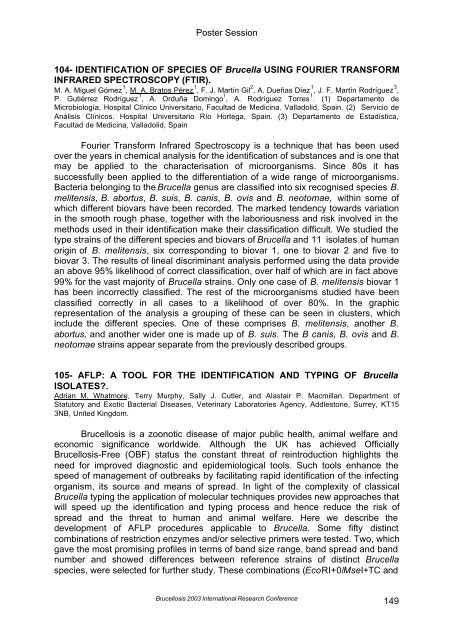Brucellosis 2003 proceedings - PHIDIAS
Brucellosis 2003 proceedings - PHIDIAS
Brucellosis 2003 proceedings - PHIDIAS
Create successful ePaper yourself
Turn your PDF publications into a flip-book with our unique Google optimized e-Paper software.
Poster Session<br />
104- IDENTIFICATION OF SPECIES OF Brucella USING FOURIER TRANSFORM<br />
INFRARED SPECTROSCOPY (FTIR).<br />
M. A. Miguel Gómez 1 , M. A. Bratos Pérez 1 , F. J. Martín Gil 2 , A. Dueñas Díez 1 , J. F. Martín Rodríguez 3 ,<br />
P. Gutiérrez Rodríguez 1 , A. Orduña Domingo 1 , A. Rodríguez Torres 1 . (1) Departamento de<br />
Microbiología, Hospital Clínico Universitario, Facultad de Medicina. Valladolid, Spain. (2) Servicio de<br />
Análisis Clínicos. Hospital Universitario Río Hortega, Spain. (3) Departamento de Estadística,<br />
Facultad de Medicina, Valladolid, Spain<br />
Fourier Transform Infrared Spectroscopy is a technique that has been used<br />
over the years in chemical analysis for the identification of substances and is one that<br />
may be applied to the characterisation of microorganisms. Since 80s it has<br />
successfully been applied to the differentiation of a wide range of microorganisms.<br />
Bacteria belonging to the Brucella genus are classified into six recognised species B.<br />
melitensis, B. abortus, B. suis, B. canis, B. ovis and B. neotomae, within some of<br />
which different biovars have been recorded. The marked tendency towards variation<br />
in the smooth rough phase, together with the laboriousness and risk involved in the<br />
methods used in their identification make their classification difficult. We studied the<br />
type strains of the different species and biovars of Brucella and 11 isolates of human<br />
origin of B. melitensis, six corresponding to biovar 1, one to biovar 2 and five to<br />
biovar 3. The results of lineal discriminant analysis performed using the data provide<br />
an above 95% likelihood of correct classification, over half of which are in fact above<br />
99% for the vast majority of Brucella strains. Only one case of B. melitensis biovar 1<br />
has been incorrectly classified. The rest of the microorganisms studied have been<br />
classified correctly in all cases to a likelihood of over 80%. In the graphic<br />
representation of the analysis a grouping of these can be seen in clusters, which<br />
include the different species. One of these comprises B. melitensis, another B.<br />
abortus, and another wider one is made up of B. suis. The B canis, B. ovis and B.<br />
neotomae strains appear separate from the previously described groups.<br />
105- AFLP: A TOOL FOR THE IDENTIFICATION AND TYPING OF Brucella<br />
ISOLATES?.<br />
Adrian M. Whatmore, Terry Murphy, Sally J. Cutler, and Alastair P. Macmillan. Department of<br />
Statutory and Exotic Bacterial Diseases, Veterinary Laboratories Agency, Addlestone, Surrey, KT15<br />
3NB, United Kingdom.<br />
<strong>Brucellosis</strong> is a zoonotic disease of major public health, animal welfare and<br />
economic significance worldwide. Although the UK has achieved Officially<br />
<strong>Brucellosis</strong>-Free (OBF) status the constant threat of reintroduction highlights the<br />
need for improved diagnostic and epidemiological tools. Such tools enhance the<br />
speed of management of outbreaks by facilitating rapid identification of the infecting<br />
organism, its source and means of spread. In light of the complexity of classical<br />
Brucella typing the application of molecular techniques provides new approaches that<br />
will speed up the identification and typing process and hence reduce the risk of<br />
spread and the threat to human and animal welfare. Here we describe the<br />
development of AFLP procedures applicable to Brucella. Some fifty distinct<br />
combinations of restriction enzymes and/or selective primers were tested. Two, which<br />
gave the most promising profiles in terms of band size range, band spread and band<br />
number and showed differences between reference strains of distinct Brucella<br />
species, were selected for further study. These combinations (EcoRI+0/MseI+TC and<br />
<strong>Brucellosis</strong> <strong>2003</strong> International Research Conference<br />
149
















